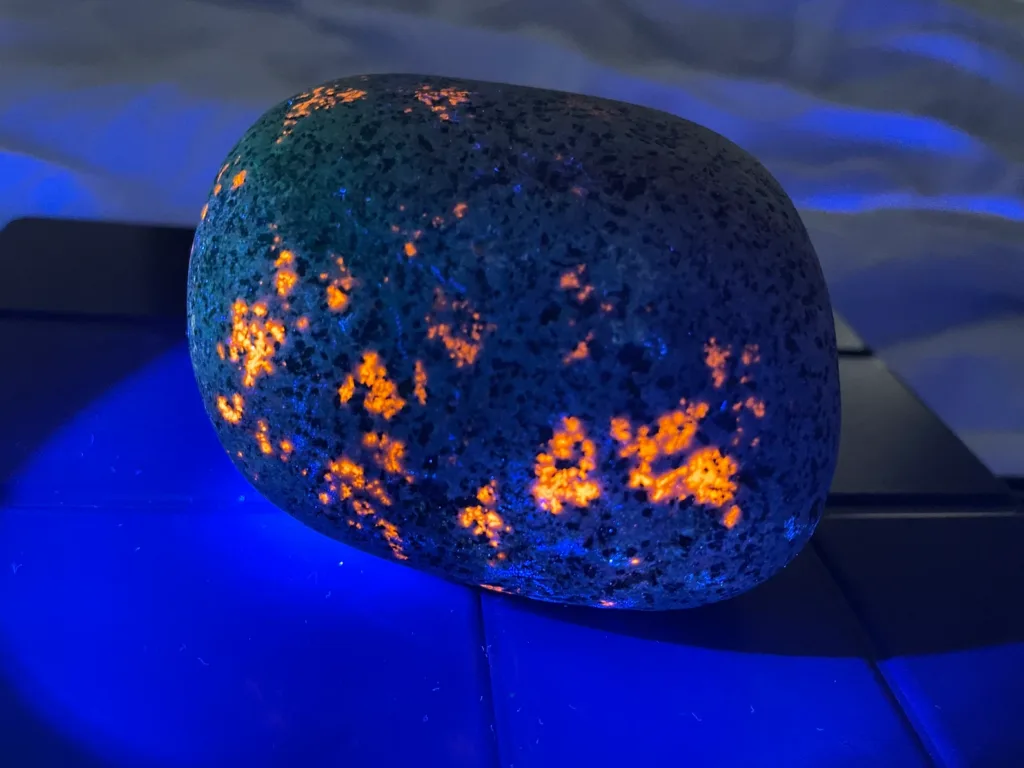Yooperlite is a term used to describe a unique type of rock, specifically a variety of sodalite-rich syenite found in the Upper Peninsula of Michigan, USA. This distinctive rock gained attention for its remarkable property of fluorescing under ultraviolet (UV) light, emitting an otherworldly glow.

The term “Yooperlite” itself is a blend of two words: “Yooper,” a colloquial term for people from Michigan’s Upper Peninsula, and “lite,” a suffix often associated with minerals and rocks, suggesting its illuminative quality when exposed to UV light. The term was coined by Erik Rintamaki, a rock enthusiast and avid explorer who discovered this phenomenon in 2017 while walking along the shores of Lake Superior.
Geologically, Yooperlites are found in the Upper Peninsula of Michigan, primarily along the beaches of Lake Superior. They are formed within a geological context of ancient volcanic activity. These rocks are thought to have originated from magma that cooled slowly beneath the Earth’s surface, forming the distinctive pattern of minerals that give Yooperlites their unique appearance.
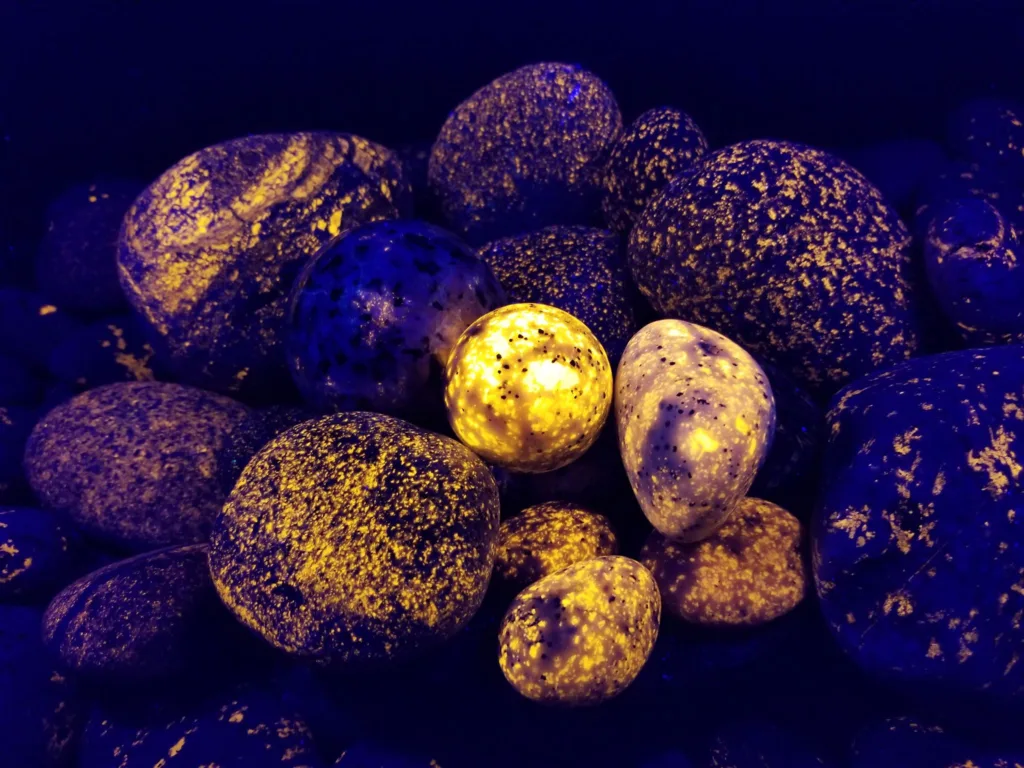
The discovery of Yooperlites sparked significant interest among rock collectors, hobbyists, and tourists alike. They quickly gained popularity due to their captivating fluorescence, with enthusiasts venturing to the shores of Lake Superior in search of these glowing rocks. Social media platforms played a crucial role in spreading awareness of Yooperlites, with photos and videos showcasing their striking luminescence garnering widespread attention.
In summary, Yooperlites are a type of sodalite-rich syenite found in Michigan’s Upper Peninsula, known for their unique ability to fluoresce under UV light. The term “Yooperlite” was coined by Erik Rintamaki in 2017, and their discovery has since captivated the interest of rock enthusiasts worldwide.
Geological Composition
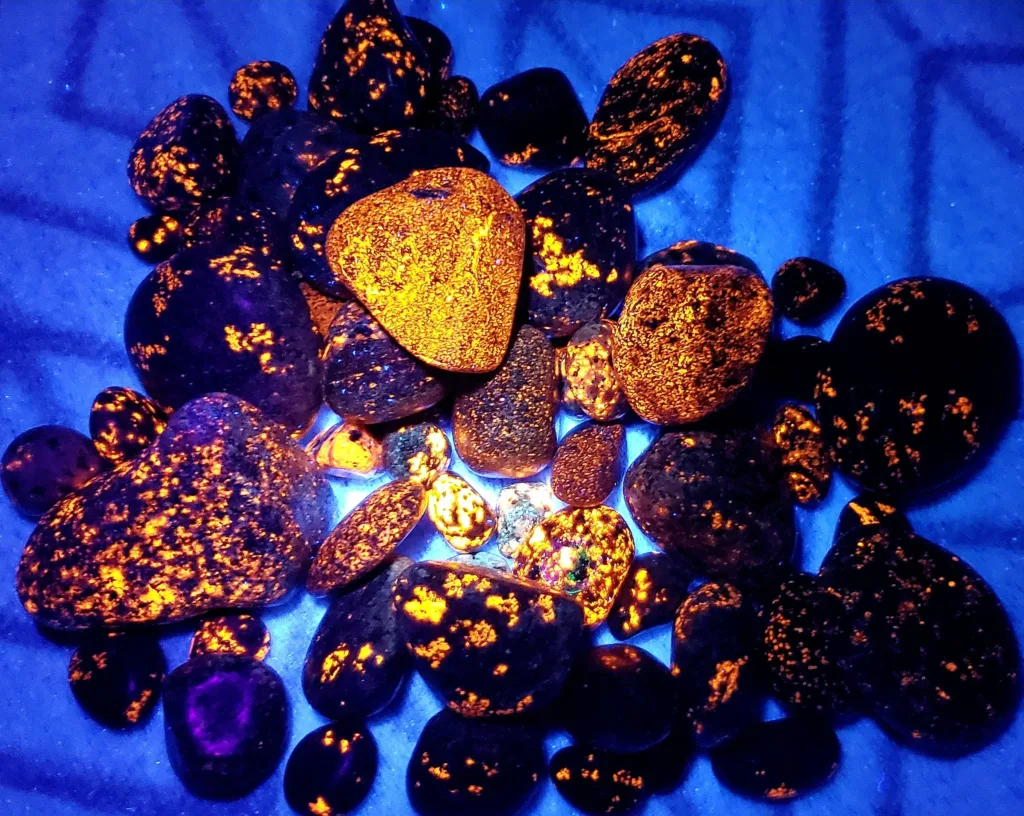
Yooperlites are primarily composed of a mineral called sodalite, which is a member of the feldspathoid mineral group. Sodalite is known for its deep blue color and is often found in association with other minerals such as nepheline, calcite, and cancrinite.
In addition to sodalite, Yooperlites also contain other minerals commonly found in syenite rocks, including feldspar, amphibole, and pyroxene. Syenite is a coarse-grained intrusive igneous rock similar to granite but containing more alkali feldspar than plagioclase feldspar.
The specific composition of Yooperlites can vary, but their distinctive fluorescence under UV light is primarily attributed to the presence of sodalite. When exposed to UV light, the sodalite within Yooperlites absorbs the light energy and then re-emits it as visible light, resulting in the characteristic glowing effect.
Overall, the geological composition of Yooperlites consists of a mixture of sodalite-rich syenite minerals, which give these rocks their unique appearance and fluorescence properties.
UV Fluorescence
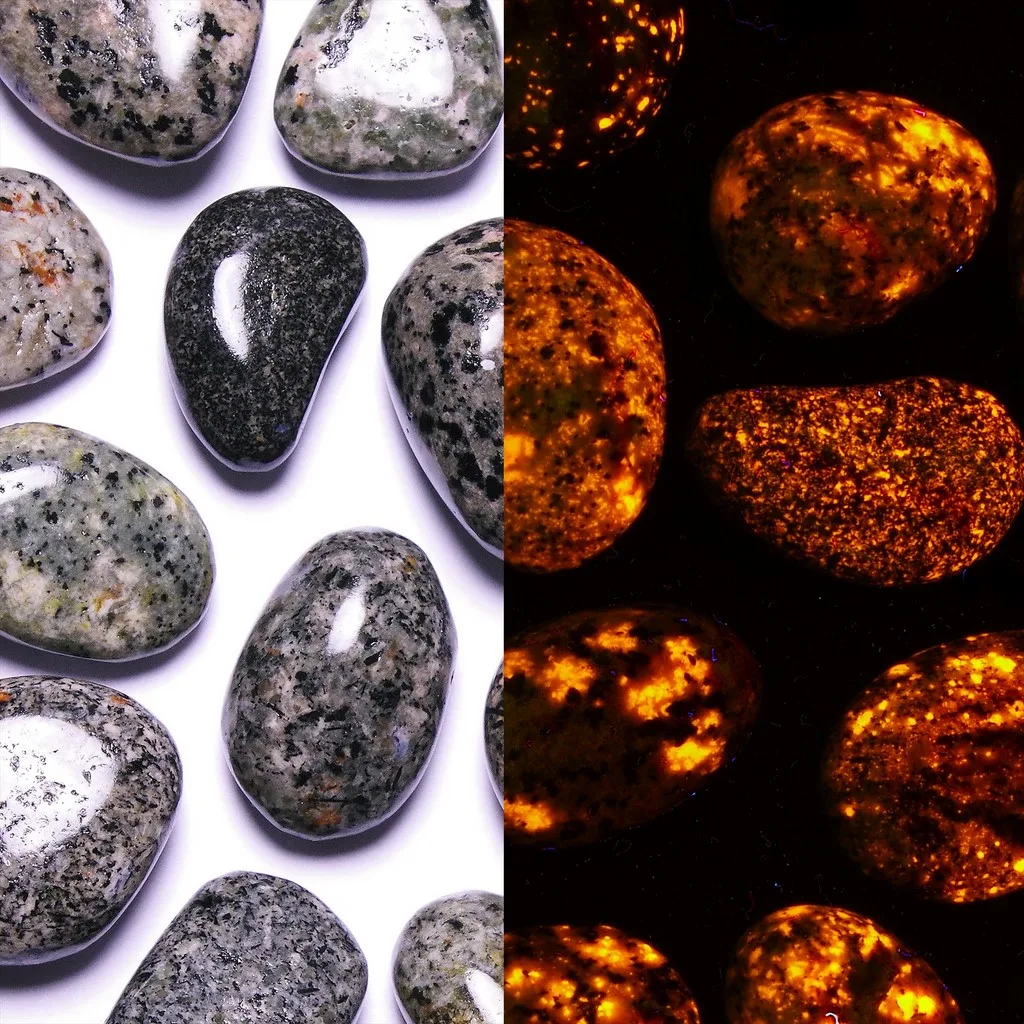
UV fluorescence is a phenomenon where certain substances absorb ultraviolet (UV) light and then emit visible light at longer wavelengths. This process occurs due to the absorption of photons by the electrons within the atoms of the substance, causing them to move to higher energy levels. When these excited electrons return to their original energy levels, they release the absorbed energy in the form of light.
In the case of Yooperlites, the mechanism of fluorescence primarily involves the mineral sodalite, which is present in these rocks. Sodalite contains atoms that can absorb UV light, causing its electrons to become excited. As these excited electrons return to their ground state, they release energy in the form of visible light, resulting in the characteristic glow or fluorescence observed in Yooperlites when exposed to UV light.
The properties of fluorescent sodalite in Yooperlites include:
- Color: Sodalite typically emits a blue or blue-green fluorescence when exposed to UV light. The exact color may vary depending on impurities present in the sodalite and the specific conditions of the UV light source.
- Intensity: The intensity of fluorescence in Yooperlites can vary, with some specimens exhibiting a strong and vibrant glow under UV light, while others may appear more subdued.
- Persistence: Fluorescence in Yooperlites is typically instantaneous, meaning that the glow is visible as long as the UV light source is present. Once the UV light is removed, the fluorescence ceases.
- Distribution: Fluorescent sodalite within Yooperlites is often distributed throughout the rock matrix, creating a uniform or mottled appearance of fluorescence when viewed under UV light.
Overall, the fluorescence exhibited by sodalite in Yooperlites is a fascinating example of luminescence in minerals, attracting enthusiasts and collectors due to its striking visual appeal and unique properties.
Characteristics of Yooperlite
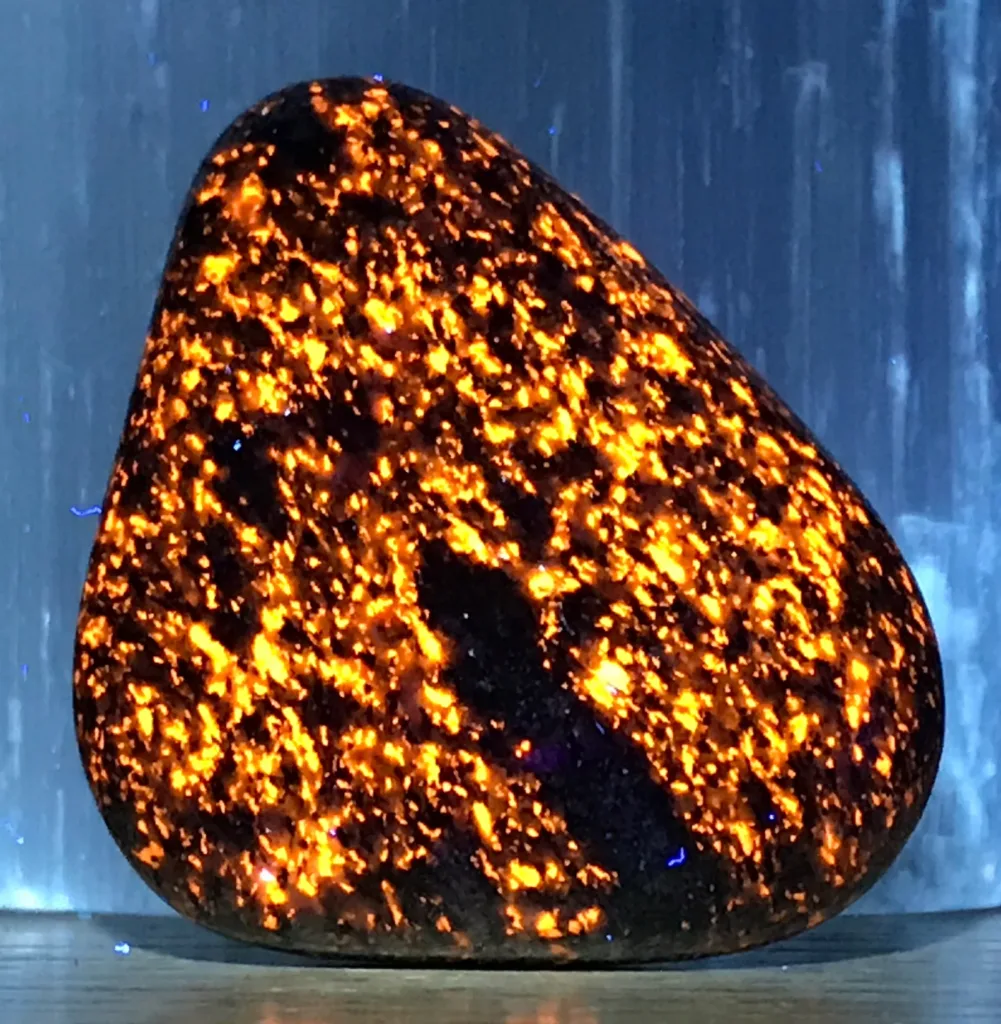
Yooperlites possess several distinctive characteristics that make them fascinating and sought-after among collectors and enthusiasts:
- Fluorescence: Perhaps the most notable characteristic of Yooperlites is their ability to fluoresce under ultraviolet (UV) light. When exposed to UV light, typically from a blacklight, Yooperlites emit a vibrant glow, often in shades of blue or blue-green. This fluorescence is caused by the presence of sodalite, a mineral within the rock matrix, which absorbs UV light and re-emits it as visible light.
- Appearance: Yooperlites have a distinctive appearance even without UV light. They often exhibit a mottled or speckled texture, with varying shades of gray, black, and sometimes hints of blue or green. The presence of other minerals like feldspar, amphibole, and pyroxene contributes to their overall appearance.
- Origin: Yooperlites are primarily found in the Upper Peninsula of Michigan, particularly along the shores of Lake Superior. They are typically discovered as water-worn rocks on beaches, having been transported by glaciers and eroded by the action of waves.
- Composition: Yooperlites are primarily composed of sodalite-rich syenite, which contains minerals such as sodalite, feldspar, amphibole, and pyroxene. The exact composition may vary from specimen to specimen, leading to a range of colors and patterns.
- Collectibility: Due to their unique fluorescence and intriguing geological origin, Yooperlites have become highly collectible among rock enthusiasts. Their discovery by Erik Rintamaki in 2017 sparked widespread interest and led to a surge in popularity, with collectors often venturing to the shores of Lake Superior in search of these glowing rocks.
Overall, Yooperlites are characterized by their fluorescence, distinctive appearance, geological origin, composition, and collectibility, making them a fascinating and prized addition to any rock collection.
Uses and Collecting Yooperlites

Yooperlites are primarily valued for their aesthetic appeal and unique fluorescence, making them sought-after by collectors and enthusiasts. Here are some common uses and practices associated with Yooperlites:
- Collecting: Many people collect Yooperlites as a hobby, venturing to the beaches of Lake Superior in search of these glowing rocks. Collectors often enjoy the thrill of discovery, as well as the challenge of finding specimens with particularly vibrant fluorescence or interesting patterns. Yooperlite hunting has become a popular activity among rockhounding communities, with enthusiasts sharing tips and locations for finding these unique rocks.
- Display: Yooperlites make eye-catching display pieces due to their striking fluorescence. They can be showcased in rock collections, displayed in UV-lighted cases to highlight their glow, or incorporated into decorative arrangements. Some collectors even use Yooperlites to create custom jewelry or artistic pieces, capitalizing on their unique properties and aesthetic appeal.
- Education and Outreach: Yooperlites can serve as educational tools for teaching about geology, mineralogy, and fluorescence. They provide an engaging way to introduce people to the science of minerals and rocks, as well as the geological history of the Upper Peninsula of Michigan. Yooperlite hunting expeditions and workshops are sometimes organized by educational institutions or community groups, offering hands-on learning experiences for participants of all ages.
- Research: While Yooperlites are primarily prized for their visual appeal, they also have potential scientific value. Researchers may study the mineral composition, formation processes, and fluorescence properties of Yooperlites to gain insights into geological processes, mineralogy, and luminescence phenomena. Scientific investigations of Yooperlites could contribute to our understanding of igneous rock formation, mineral fluorescence mechanisms, and environmental factors affecting mineral deposition.
- Commerce: Yooperlites have also entered the commercial market, with some collectors selling specimens online, at rock and mineral shows, or through specialty stores. The unique fluorescence and limited geographic distribution of Yooperlites contribute to their value as collectible items, with certain specimens fetching higher prices among enthusiasts and collectors.
Overall, Yooperlites are valued for their beauty, uniqueness, and educational significance, making them cherished additions to rock collections and popular subjects of exploration and discovery. Whether collected for personal enjoyment, educational purposes, or scientific research, Yooperlites continue to captivate the imagination of rock enthusiasts worldwide.
